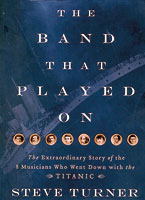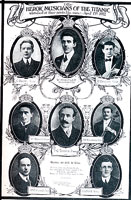A book about an extraordinary event in the recent history of mankind has just been published, called The Band That Played On. It is centred on the sinking of the SS Titanic and the astonishing fortitude of the band on board that continued to play even as the ship slipped to its watery grave. The eight men in the band were hailed afterwards as heroes for the part they played in playing on, and so preventing panic among passengers dashing to save themselves.
 |
 |
| |
The eight musicians who played as the Titanic sank |
We know the scene from the many films about the Titanic, the most notable being the one starring Leonardo DiCaprio and Kate Winslet made in 1997. That the band did indeed play on is neither fiction nor a movie-maker’s imagination; it actually happened.
In this 258-page book with plenty of black & white photographs, the author, Steve Turner, has painstakingly researched the lives of the eight musicians, how fate brought them together, and the consequences. Although the drama began one hundred years ago, it is still remembered today.
The Titanic was launched in Belfast on May 31, 1911; she sank after collision with an iceberg 550 miles off the coast of Newfoundland during her maiden voyage from Southampton to New York on April 15, 1912. At the time she was the largest man-made structure ever built. The ship could accommodate up to 2,599 passengers and 903 officers and crew and was the most luxurious vessel ever seen.
In his introduction to the book, Steve Turner explains that even though so much has been written over the years about the tragedy, not much was known about the bandsmen who became a public symbol of courage in the face of death. His book, he writes, “is also a portrait of the age in which they lived” and because of that the reader realises how standards and attitudes have changed (for the worse?) in the past hundred years.
The London Daily Mirror of April 20, 1912 captured the heart of the story. Under the headline of BAND GOES DOWN PLAYING it reported: “In the whole history of the sea, there is little to equal the wonderful behaviour of these humble players. In the last moment of the ship’s great doom, when all was plainly lost, when braver and hardier men might almost have been excused for doing practically anything to save themselves, they stood responsive to their conductor’s baton and played a recessional tune.”
In fact, the band played for more than an hour and the music included popular ragtime tunes in an effort to inspire reassurance in the passengers as they scrambled for the lifeboats. Then, as the sea swirled around their legs and the end neared, they switched to more sombre, religious music. None of the musicians made an effort to escape in a lifeboat.
Steve Turner has tracked down the stories of each of the eight bandsmen. In fact there were two bands, a saloon orchestra of five men and a deck band of three, all under the direction of their leader, Wallace Hartley. They played string instruments (violin, cello) and piano. Five of the eight were English, one a Scotsman, one French and one Belgian. They had never played together before boarding the ship and three of the musicians had never been to sea. The oldest was 40, the youngest 20.Turner’s research shows all the thoroughness of a dedicated detective. He has discovered (and personally photographed the houses) where each of the bandsmen was born and probed beyond the limits of biography to unearth intriguing facts. For instance, it turns out that one of the musicians, Wes Woodward, had a connection with Sri Lanka. His niece, Eleanor, “married an agricultural expert who went to work in Ceylon.”
He even has a chapter -- that could well be called “The Case of the Missing Violin” -- about the fate of the violin that Wallace Hartley was playing as the Titanic sank. There was ample evidence that Hartley’s body was found with his violin in its case strapped to his chest, yet somehow the violin disappeared. Then, as he was researching this book, Steve Turner was approached by a man who had photographs of what he claimed was the missing violin. Turner explains in detail how this could be true and that the violin is likely to come up for auction on the 100th anniversary of Titanic’s sinking.
I first heard about Steve Turner when he contacted me to see if I was the person that John Lennon of the Beatles had spoken about, concerning my influence on him. Turner was researching then for his 1994 book on the stories behind every Beatles’ song. He was in touch with me again for his biography of Cliff Richard, The Bachelor Boy published in 2008 and that book contains a photo of Cliff and myself taken in Sri Lanka in 2007.
The Band That Played On is a remarkable progression for Turner, from writing about contemporary pop stars to a serious biography of eight musicians born in the 19th century. It is a formidable study, citing hundreds of sources, and shows how a good biography should be written. In spite of its tragic theme, this book is an enjoyable and thought-provoking read that fascinates even those for whom Titanic was just a movie. |



